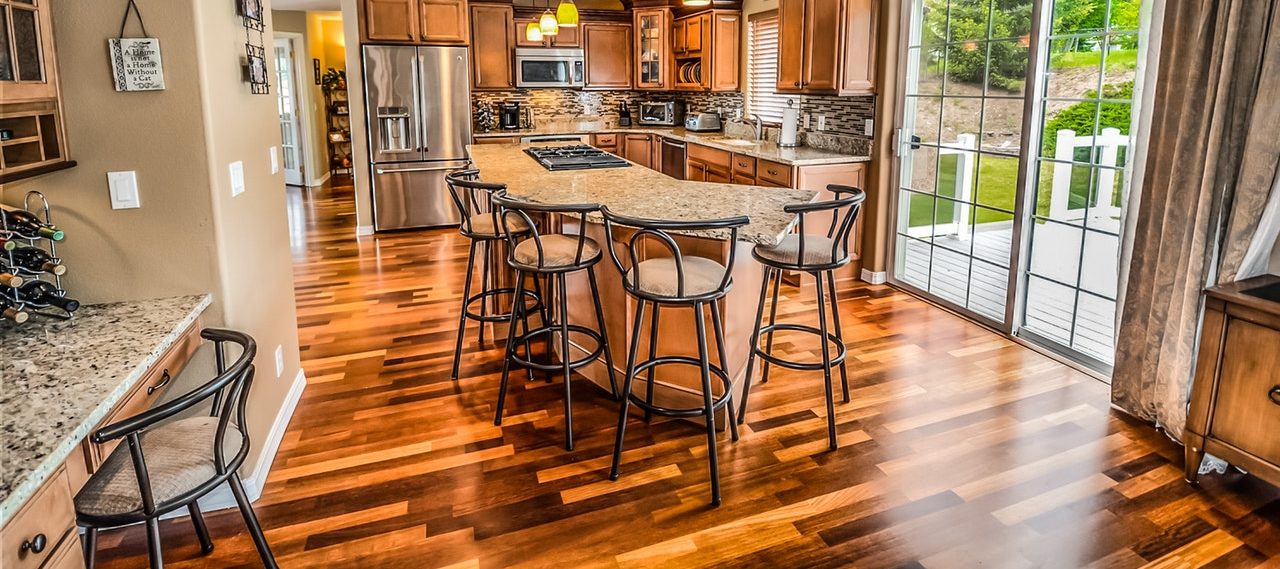Hardwood Options: Solid vs Engineered Floors
Which will it be: solid hardwood flooring or engineered wood flooring? Wood floor manufacturers once styled engineered wood flooring as a reasonable, but not entirely adequate, substitute for 100% hardwood flooring. Solid hardwood was viewed by consumers and even some makers as still being the one and only true wood flooring, with engineered a pale stand-in. Now, the tide has shifted. Engineered wood comprises a majority share of the wood floor market, and the two types of flooring are often mentioned in the same breath.
Neither floor type can be called “better,” but you may find one that you can call better for you.
| Solid Hardwood Flooring | Engineered Wood Flooring | |
| It Is | Solid hardwood and only hardwood, a homogeneous product from top to bottom and side to side. | Layered product made of an actual but thin slice of hardwood on top of a base of high-quality plywood. |
| Thickness | Usually 3/4″. | 3/8″ to 1/2″ |
| Width | 3.25″ is standard width. Plank width begins at 5″ and can go up to 11″ wide. | As with solid hardwood, standard widths are 3.25″, with plank sizes starting at 5″. |
| Wood Species | Far more choices of wood species than engineered wood. Red and white oak, maple, hickory, and pine are the most popular solids. | Fewer choices than with solid hardwood. Red oak, hickory, and Brazilian Cherry are the most popular wood species for engineered flooring. |
| Pre-Finished or Site-Finished | Pre-finished is increasingly the finish of choice for solids. Site-finished (also called unfinished) accounts for about 25% of solid hardwoods today. | Most engineered wood floors are pre-finished. It is possible to find a few dealers who sell site-finished engineered wood flooring, Hurst Hardwoods being one of them. |
| Can Be Sanded? | Yes, numerous times. Eventually, solid hardwood will become too thin after years of sanding, compromising its structural integrity. | Yes, but only once or twice lightly, before the thin upper layer wears away. |
| Ease of Installation | Solid hardwoods are nailed or stapled down. Solid hardwood is never installed on a floating basis. | Easier than solid hardwood as you have a greater range of installation methods: stapling or nailing, click, or glue. |
| Resale Value | Excellent. As long as the floor is in good shape, it is on equal terms with engineered wood flooring. | Excellent. Because engineered wood floors are real wood, they can be advertised as such in real estate marketing materials, making them more attractive to buyers. |
| Overall Durability | Excellent. Well-maintained solid hardwood will last for decades. Moisture is the enemy of this organic product. Wood floors do stand a chance of being salvaged after flooding, but they will never perfectly return to their former shape. | Good, but not as long as solid hardwood. Because the surface is thin, it can become chipped or de-laminated if stressed beyond normal conditions. Yet its ability to hold up to limited moisture helps bring up its durability rating. |
| Holds Up To Moisture | Poor. Never recommended for bathrooms, basements, or other areas where moisture is prevalent or even expected. Still, solid hardwood can resist some moisture. Site-finished wood flooring (as opposed to pre-finished), though, does have a sealed top layer that can shed some moisture. | Good; better than solid hardwood. Its plywood base is dimensionally stable, meaning that it warps and flexes less easily upon contact with moisture than solid wood. Fibers in plywood run in cross-wise layers, a far more stable structure than solid wood’s parallel fibers. |
| Hardness | Solid hardwood encompasses a greater range of wood hardness than engineered. Hardness ranges from extremely soft and appropriate only for utility areas (e.g., Douglas Fir for workshops) to extremely hard (e.g., Brazilian Walnut). | Hard hardwoods are the most durable: many of the South American or Indonesian exotics, as well as birch, maple, and walnut. Soft hardwoods such as pine will not be found in engineered wood format. |
| Where to Install | Best in living areas, bedrooms, hallways, dining rooms. While it’s wise to avoid solid wood in kitchens, installation can be acceptable if waterproof mats are placed near sink and dishwasher. Mostly not okay to install in bathrooms, though would be fine in a powder room. Never install solid wood floor below grade. | All areas mentioned for solid wood flooring. Again, best to avoid any kind of organic material in kitchens, but it can be made to work with proper precautions. Powder rooms are fine. Can be installed below-grade with proper subfloor and as long as basement has absolutely no moisture problems. |
| Bottom Line | Solid hardwood is for purists who have long-time prospects in mind, yet do not mind installing different types of flooring in different parts of the house, according to need. Solid wood will return value many years down the road. | Engineered wood is for those who want the look of wood but who have a practical bent. Engineered wood lets you install it in a few more rooms of the house than you can with solid wood. It will return value, but will not have the longevity that solid wood has. |
Article Credit – The Spruce

